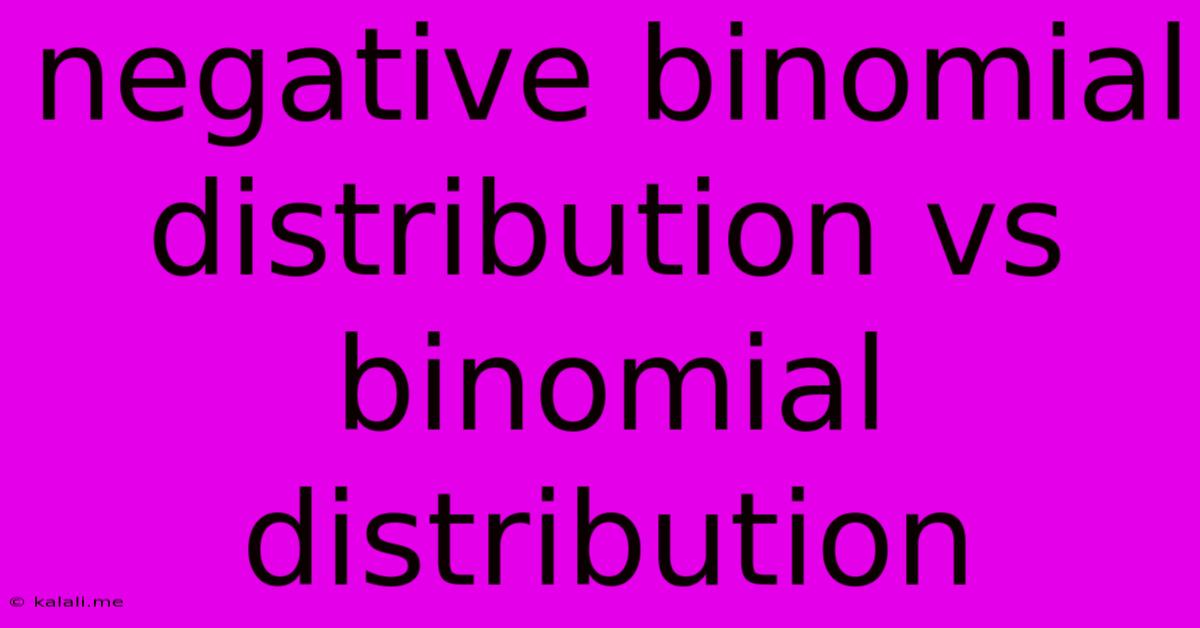Negative Binomial Distribution Vs Binomial Distribution
Kalali
Jun 09, 2025 · 3 min read

Table of Contents
Negative Binomial Distribution vs. Binomial Distribution: Understanding the Differences
The binomial and negative binomial distributions are both probability distributions that model the number of successes in a sequence of independent Bernoulli trials. However, they differ significantly in their defining characteristics and applications. Understanding these differences is crucial for choosing the right distribution for your statistical modeling needs. This article will delve into the core distinctions between these two important distributions, highlighting their key features and applications.
What is a Binomial Distribution?
The binomial distribution describes the probability of getting exactly k successes in n independent Bernoulli trials, where each trial has a constant probability of success p. Imagine flipping a fair coin 10 times (n=10); the binomial distribution helps calculate the probability of getting exactly 6 heads (k=6), given the probability of getting heads on a single flip is 0.5 (p=0.5).
Key features of the Binomial Distribution:
- Fixed number of trials (n): The number of trials is predetermined.
- Constant probability of success (p): The probability of success remains the same for each trial.
- Independent trials: The outcome of one trial does not affect the outcome of other trials.
- Two possible outcomes: Each trial results in either success or failure.
What is a Negative Binomial Distribution?
The negative binomial distribution describes the probability of observing k failures before observing r successes in a sequence of independent Bernoulli trials, where each trial has a constant probability of success p. Unlike the binomial distribution, the number of trials is not fixed; it's a random variable. Consider repeatedly rolling a die until you've rolled a six (success) three times (r=3). The negative binomial distribution helps calculate the probability of having rolled a certain number of non-sixes (failures) before achieving those three sixes.
Key features of the Negative Binomial Distribution:
- Fixed number of successes (r): The number of successes is predetermined.
- Constant probability of success (p): The probability of success remains the same for each trial.
- Independent trials: The outcome of one trial does not affect the outcome of other trials.
- Two possible outcomes: Each trial results in either success or failure.
- Variable number of trials: The number of trials is not fixed; it's determined by the number of failures before achieving the required successes.
Key Differences Summarized:
| Feature | Binomial Distribution | Negative Binomial Distribution |
|---|---|---|
| Number of trials | Fixed (n) | Variable (random) |
| Number of successes | Variable (k) | Fixed (r) |
| Stopping criterion | Fixed number of trials | Fixed number of successes |
| Typical application | Assessing probability of a specific number of successes in a fixed number of trials | Modeling the number of trials needed to achieve a fixed number of successes |
When to use which distribution?
Choosing between a binomial and a negative binomial distribution depends entirely on the nature of your experiment or observation.
-
Use the binomial distribution when: You have a fixed number of trials and you are interested in the probability of a certain number of successes within that fixed number of trials. Examples include: the probability of getting 3 heads in 5 coin flips, the probability of 2 defective items in a batch of 10.
-
Use the negative binomial distribution when: You are interested in the probability of observing a fixed number of successes and want to know the distribution of the number of failures before reaching that target. Examples include: the number of times you need to roll a die before getting 3 sixes, the number of job applications you need to send before getting 5 job offers.
Conclusion:
Both the binomial and negative binomial distributions are valuable tools in probability and statistics. Understanding their key differences – specifically, the fixed versus variable number of trials and the nature of the stopping criterion – is paramount to selecting the appropriate model for your data and drawing accurate conclusions. Careful consideration of the experimental setup is critical for ensuring the correct distribution is applied.
Latest Posts
Latest Posts
-
Jesus The Alpha And The Omega
Jun 09, 2025
-
How Legacy System Communicate To Salesforce Using Connected App
Jun 09, 2025
-
What Is The Sixth Hour In The Bible
Jun 09, 2025
-
Jesus Curses The Fig Tree Meaning
Jun 09, 2025
-
How To Test A Water Line For Leaks
Jun 09, 2025
Related Post
Thank you for visiting our website which covers about Negative Binomial Distribution Vs Binomial Distribution . We hope the information provided has been useful to you. Feel free to contact us if you have any questions or need further assistance. See you next time and don't miss to bookmark.